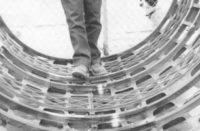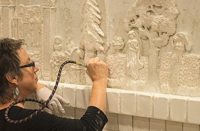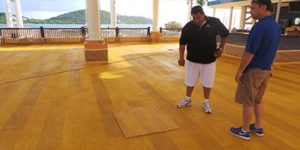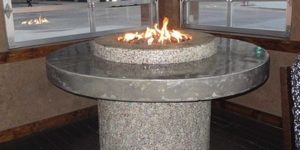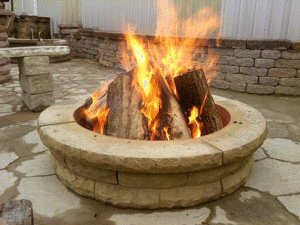
During this year’s debut of Decorative Concrete LIVE 2017 in Las Vegas, artisans from around the country converged at the makeshift residential setting hosted by Concrete Decor. There they demonstrated their skills on how they transform ordinary concrete into extraordinary finished pieces. Two of the participants that wowed the crowds with their talents share some insights on how they work their magic through texture and color.
Keefe Duhon
Keefe Duhon, owner of Concrete Revolution LLC in New Iberia, Louisiana, says for him the artistic use of brushes and varying textures are the keys to achieving woodgrain on both vertical and horizontal surfaces.
“First, we do a scratch-coat surface, especially if we have cracks we have to treat,” he says. “We address those issues then squeegee out a scratch-coat overlay to give us a new canvas to work on. Then, we apply a micro-topping overlay using hand trowels to create the visual effects of woodgrain textures.
“Next, we apply our stains,” Duhon continues. “We use both water-based stains and acid stains applied with a 4-inch brush. We color the planks one by one, hand-brushing each plank.”
When multiple people are coloring on a job, they intermittently swap places to prevent repetitive color patterns. Duhon firmly believes that a great deal of the success of his “wood” planking comes from the color, rather than the texture.
Natural wood, he says, typically has three layers of color in it, and that’s what he applies to his concrete wood planks. Additionally, a new technique that involves foil transfer papers provides visual effects on the highest points of the wood grain texture.
“We apply an adhesive material on the surface and then apply the transfer paper with a rigid trowel,” he explains. “We then rub the transfer paper to achieve the desired crackle affects and saw marks of the texture that colors only the high points of the micro-topping overlay.” This technique is the third and final level of the wood plank texturing and coloring.
While Duhon acknowledges that the same work can be done with stamping tools — even on a micro-topping — his method is faster and less expensive than doing a stamped overlay, especially for residential clients who have pulled-up carpet or tile. It’s also personal to Duhon. Hand texturizing and coloring provides him the artistic freedom to freely create a one-of-a-kind custom floor.
While floors are his specialty, Duhon is branching out with countertops, fireplaces, showers and walls. He’s also expanding his portfolio by creating what appears to be solid-cast concrete but is really a wooden armature top-coated with micro-toppings — a product that offers cost savings to clients.
Duhon believes that imagination is the limit to creativity, and says the secret to success is to not be afraid to experiment — just not on the client’s time or dime.
“Stay open to new ideas and really look at your surroundings,” advises Duhon. “Keep being inspired and always keep your imagination moving.”
Duhon colored and textured a porch area at the show.

Josh Annis
Sometimes a concrete artisan comes along to whom the title artist, rather than craftsman, applies. Take, for example, Joshua Annis, owner of Murrieta, California-based Joshua James Artistry and this issue’s featured artisan. He says he was fortunate that as a teenager he was influenced by a union plasterer who worked for Disney.
“All he did was play with cement,” says Annis. “Unfortunately, he was colorblind, and he asked me to paint some of his outside projects. I was lucky enough to see some of the techniques he used.”
Over the last 20 years, he’s put his own spin on some of those techniques and has learned how to use different things to achieve his goals.
 “I either tweak them or use the everyday tools we already have,” he says. “I use a lot of various brushes to get the right texture for the job we’re doing.”
“I either tweak them or use the everyday tools we already have,” he says. “I use a lot of various brushes to get the right texture for the job we’re doing.”
It’s not that he doesn’t use stamps; he does. He just doesn’t like the repetitive look of commercial products.
“I use a lot of foam,” he says. “I’ll take regular Styrofoam and shred it into different shapes or different textures and use that as mats. Or, I’ll shave the foam with sandpaper to get a desired effect when I press it into the concrete. I also make a lot of tools out of wood.”
While he relies on three or four different brushes with different lengths and hardnesses to create woodgrain in concrete, Annis is also well-known for his concrete rock fireplaces. There, he says the trick is often in the troweling.
“I get a lot of my textures by the way I trowel,” he says. “I want the pores in the concrete to be open. So I’ll blade the cement with the side of the trowel and leave skipped trowel areas open. Then, I’ll come back in with foam. I shred the foam in different designs and I’ll texture it in areas that I think need texturing.”
Annis created a concrete rock fireplace and wood beam replicas during the show.
